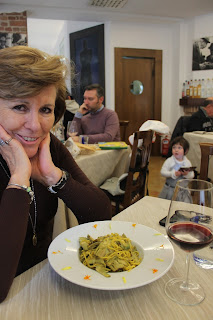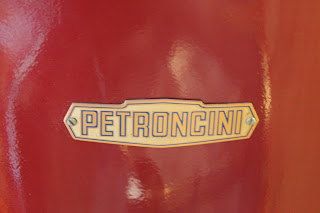We left Torino late Sunday morning, taking the A6 toll way going south, for a 60 km or 70 minute drive down to Alba.
Piazza del Duomo di Alba
Neither Torino nor Alba are part of the Via Francigena, but rather are to the southeast of the ancient pilgrim route. Yet both of these cities have attracted pilgrims for centuries, either in search of the Holy Shroud or of a fine meal and wine.
Estela ordered Tajarin fatti in
casa ai carciofi di Albegna pasta
fresca or homemade pasta with
artichoke sauce.
As we reached Alba around 1:00 pm, we immediately went looking for a place to eat, leaving for the afternoon the visits of the Duomo.
Here the truffle flakes are spread evenly over
a dish of risotto.
Estela and I did our research on the most typical dishes of Alba to look for in the restaurants: il tartufo, il risotto, i tajarin, i plin and il vino Barolo. The restaurant we found offered us for our first meal here a delicious sampling of four of these five elements.
Before eating a dish of risotto
with tartufi, it is important to
wait a moment and enjoy its
unique aroma, that transports us
to the well shaded and damp
forests, where the dogs come
to dig them up, close to the
roots of certain trees.
For over the last 17 years, we have had the good fortune to have Golden Retrievers in our home. We take them out to the park twice a day for a 20 minute walk.
The time I have spent with these beautiful and noble dogs, have helped me understand and respect how much more advanced their sense of smell is as compared to ours.
"Lencho" our Golden Retriever for 14 years, had
a remarkable sensitive nose. In Alba, they use
specially trained dogs to search and dig out the
tartufi.
The time I have spent with these beautiful and noble dogs, have helped me understand and respect how much more advanced their sense of smell is as compared to ours.

Having never tried Risotto with
Truffles, I started eating the dish
evenly, without mixing the
tartufi.
Small wonder that the people in Alba who look for tartufi use dogs to smell them out and dig them up from under the roots of the trees.
The waiter, seeing how I was
eating the risotto, came over
and suggested I stir the risotto
mixing the tartufi or truffles into
the rice, so that my
gastronomical experience would
result more even and
homogenous
Another step of caution that must be taken before savoring a delicious plate of pasta or risotto with tartufi is not to rush to pour a mountain of Parmesan Cheese on top. Parmesan cheese will suffocate both the subtle aroma as well as the delicate but fragile taste of the tartufo.
Alba is the land of wine and truffles, of risotto, of well served tables with white tablecloths and wooden chairs.

The Pio Cesare is one of the
traditional labels of Barolo red
wine, featuring the Nebbiolo
grapes.
Alba is in the middle of two important wine growing areas: the Langhe and the Roero. In these areas, there are two world-renown DOCG (Denominazione di Origine Controllata e Garantita) red wines: the Barolo and the Barbaresco.
Dolce: Tortino di nocciole
Piemonte con Zabaione al Barolo.
(Hazelnut cake with Barolo wine
sweet cream sauce).
The Barolo is not only used as a table wine, but for cooking. In the above picture, we can see a desert with a sauce prepared with Barolo wine.
This sign shows the five principle types of
tartufi or truffles. It is important to note that
each on of these truffles has a specific season.
Picturesque doorway in Alba
Cobblestone alleyway in Alba
Piazza del Duomo, Alba
Palazzo di Comune or City Hall
of Alba
Another view of the Piazza del
Duomo
Duomo di San Lorenzo di Alba

The civic center of Alba
Red brick façade of Duomo di
San Lorenzo di Alba
One of the few of the medieval
towers of Alba to survive to our
times
Romanesque belfry of the Duomo
di San Lorenzo di Alba
Sculpture dedicated to "Johnny",
a partisan freedom fighter against
the Nazi occupation during WWII
Side street of the Duomo di Alba
Side view of Il Duomo di Alba
Notice the elegant variety of the colors of the
buildings surrounding Il Duomo di Alba
Alleyway near Il Duomo di Alba
How many of us have witnessed conversations that start off with: "What the Church needs to do today, to attract people back is..." I imagine one such conversation took place several years ago in Alba, concerning its Duomo, and the conclusion was to fix the heating system. When the bishop consulted the contractor, he suggested that an extensive dig be done underneath the church, so as to house the ventilation ducks. As with many of these projects in Italy, or even in Mexico, those "digs" produce a great deal of unexpected surprises, and this dig in Alba, underneath il Duomo, was not an exception.
The underground Alba, ruins of
the Paleochristian church period.
The dig helped discover ruins side-by-side of the
Roman Era, of the first Christian Church of the
5th Century, of the middle ages and tombs of the
16th century.
A collection of tombs for small infants, probably
buried here during the 15th Century. It was
customary to bury children near the ancient
baptismal fountain
On top of the structure built during the 5th
Century, another more sophisticated structure
was built during the 6th Century.
Baptismal fount for full body emersion. 6th
Century
Decorative stone sculptured
details from the Roman Period.
6th Century Baptismal Fountain
Baptismal Fountain
Confessionary
Carved wooden benches
Original floor tiles of Roman period
Decorative flower design sculpture in stone.
At the beginning of this article, I wrote that Alba is not on Via Francigena, yet it has been a place of significance for Pilgrims. Why did I say this? Alba has two patron saints: San Lorenzo, the famous 3rd Century martyr, burnt to death, and San Teobaldo (1099-1150).
The arc of San Teobaldo,
Patron Saint (along with Saint
Lawrence) of the City of Alba
San Teobaldo was born in the town of Vico, close to Asti, which is less than a 40 minute drive from Alba, and which we visited last month, and I promised to send you a report on it in the next few days. At the beginning of the 12th Century, San Teobaldo went on a pilgrimage, el Camino de Santiago, a holy pilgrimage trail than starts in the Pyrenees, on the French border, and crosses over from east to west, to the place where allegedly Saint James, the Apostle, called Santiago in Spanish, found his final resting place, at a field (campus in Latin) full of stars (stellaron in Latin), hence Santiago Campus Stellarum, or Santiago Campostela as it is called in now-a-day Spanish.
When San Teobaldo came back to the Piedmont, he relocated to Alba, and dedicated his life to giving alms to the poor, working as the sacristan at the Duomo or Cathedral of Alba, and working as a cobbler and a porter, doing odd jobs.
San Teobaldo was asked by a lady of means to take her sack of wheat to the mill for grinding. On the way back from the mill, he was approached by beggars, asking for flour, which Teobaldo gave to them generously. When he arrived at the house of the lady who had sent him on the errand, he realized that the sack was empty, and so he filled it will sand and left it at her door and went fleeing.
When the lady came to her door, she opened the sack and found out that it was full of wheat, but when she saw that several of the beggars were looking for San Teobaldo for more flour, they all realized that a miracle had happened, and so the rumor spread, and many of the townspeople came out looking for San Teobaldo to give him the news of the miracle.
Ribbed vault ceiling typical of
Gothic Church arquitecture.
This metal screen allows those
on the main floor of the Church
can look down to the 6th Century
Baptismal Fountain
The three "oculi" on top of each pointed arched
side chapel.
Main aisle of the Duomo di
Alba
Outdoor vestibule and archway.
The façade of Il Duomo was
built in Piedmont Gothic style.
The Piedmont Gothic style uses red bricks instead
of marble.
A delicious mid-afternoon cup of
espresso coffee, roasted in this
very large coffee toasting
machine, marked the end of
wonderful day
Petroncini is the brand of one of the most
successful builders of coffee toasting machines.
The Piazza Michele Ferrero is the site of several
Enotecas and Wine tasting bars, featuring the
best Barolo and Barbaresco wines of the region.
The white Arneis wine from
Langhe region is dry and
elegant. Here is the Enoteca
of Roberto Sarotto.






























































No comments:
Post a Comment